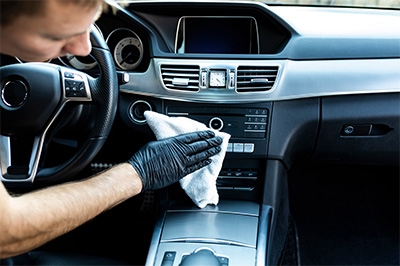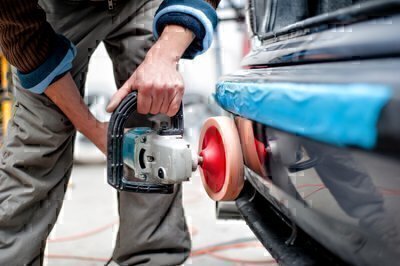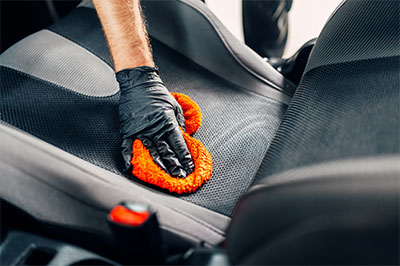What Do Car Detailers Do?
Last updated November 2022
Most detailing shops are standalone businesses, sometimes connected to large carwashes. But a growing number of detailers are mobile operators that send trucks and trailers with mounted water tanks to work at customers’ homes or in office parking lots. Some services are 100 percent mobile; others perform basic detailing jobs out-of-shop and more specialized work in-shop. The mobile guys can perform all the tasks brick-and-mortar ones do.
A basic detailing job usually takes four to five hours. Most include an exterior wash, claying, polishing, and waxing; an interior cleaning; and tire cleaning and treatments. Many detailers also provide other services upon request, such as steam cleaning engines, paint touchup, and installing accessories.
 Cleaning It Up
Cleaning It Up
Car detailing is predominantly a deep clean for your ride. This means the pro first gets the exterior as clean as possible before proceeding with other tasks, such as polishing or waxing. Many detailing services hand wash cars the same way you’d do it at home—with a hose, bucket of soapy water, and sponge. Some use high-pressure hoses to dispense clear and soapy water (much like self-serve carwashes). Other detailers send cars through an automated assembly-line carwash. In general, detailing that includes hand washing produces better results, since workers spend extra time cleaning particularly dirty areas.
After the car is dried, most detailers “clay” its surfaces, a low-tech but highly effective way of removing dirt in which a lump of detailing clay is pressed and rubbed over the paintwork.
Detailers also vacuum and clean all interior surfaces, often loosening dirt and dust trapped in nooks and crannies with compressed air. Most detailers use brushes and cleaners to treat and wipe away scuffs on doors and vinyl surfaces. Make sure the service uses only water-based vinyl cleaners, though. Today’s thinner, more eco-friendly vinyls can be more easily harmed by solvents than your granddad’s thick Naugahyde bucket seats.
While most detailers also apply a vinyl protectant to remove dust and create sheen, they should make sure they wipe away any excess protectant since it can stain clothing and attract dust or dirt. To clean a car’s carpeting and cloth upholstery, most services use specialized hot-water-extraction equipment.
If you have leather upholstery, periodically get it cleaned and conditioned. Without care, leather may dry up, crack, harden, and even start to crumble off. Some manufacturers treat leather upholstery with a protective thin plastic “skin,” which makes it easier to clean; untreated leather can be trickier and require several coats of conditioner. As with vinyl treatments, shops need to be careful not to apply too much leather conditioner and to wipe away excess product.
Some services include engine cleaning with basic detailing; others offer it as an add-on. Cleaning doesn’t make engines run better, but it can make maintenance easier, since leaks become easier to spot. Also, a dirty engine may run hotter than a clean one, and moving parts such as linkages work more smoothly when clean. But ask your mechanic if a cleaner engine is desirable before doing anything.
Paint Repairs
Any car detailer can repair minor scratches and nicks, but for more severe damage you’ll need to have a body shop repaint the vehicle. Click here for ratings of body shops for quality and price.
For very small nicks and scratches, detailers apply drops of touchup paint. Larger areas get paint and a clearcoat that’s then sanded and waxed. Touchup paint repairs won’t perfectly match the surrounding paint, but if the area is small and the worker is diligent no one will notice.
Instead of using touchup paint, some detailers will “wet sand” scratches, which smooths out the unevenness of the finish created by the scratch. Wet sanding initially produces results similar to the touchup method, but it removes clearcoat layers from the area. Since the clearcoat gives the car UV protection, a wet-sanded area will eventually look lighter than surrounding areas. Therefore, it’s usually safer to have damaged areas just touched up.
 Polishing and Buffing
Polishing and Buffing
Washing, claying, and touching up nicks improves the appearance of most cars’ finishes, but a car needs to be periodically polished to make the finish really shine.
A car shines due to light reflecting off its surface. Dirt and nicks reduce shine by absorbing light; scratches in the clearcoat layers don’t absorb light, instead reflecting it in different directions and causing the finish to appear dulled. Since automakers have yet to invent a scratchproof paint, cars over time accumulate minute scratches in their clearcoats from small rocks, sand, acorns, and other sources.
Polishing finesses out these small scratches via a rotary buffing machine fitted with a soft pad. It rubs a polishing compound over the car’s paint, smoothing out the uneven areas caused by scratches. While most shops include a light polishing in basic detailing, they can improve the finish on noticeably marred vehicles with extra polishing.
When things go wrong, it’s usually during polishing and buffing. If a buffing machine stays too long in one spot, it will leave swirl marks; if detailers use a compound that is too aggressive, they can buff right through the clearcoat and even into the basecoat and primer. Also, a shoddy job will probably result in a noticeably uneven finish.
After polishing and buffing, wax is applied and then buffed by hand or machine.
Ask any detailer whether it uses a three-step polishing process—polishing, buffing, and waxing—or a one-step one. The one-step shot is inferior because it’s impossible to simultaneously remove scratches, buff, and apply wax.
 Windows and Trim
Windows and Trim
After detailing the paintwork, services clean the car’s windows inside and out, and apply special treatments or polishes to convertible tops, exterior chrome, chromed plastic, and vinyl trim.
Wheels and Tires
Detailers wash wheels and tires, apply dressing to the tires, and either polish or dress rims and hubcaps. If your wheels already have a clearcoat layer, they generally should not be polished, since this may remove their protective layers.
Miscellaneous Work
Shops usually clean air vents inside the car, doorjambs, steering wheel, knobs, seatbelts, etc. Some offer additional services, such as installing accessories and custom work.


